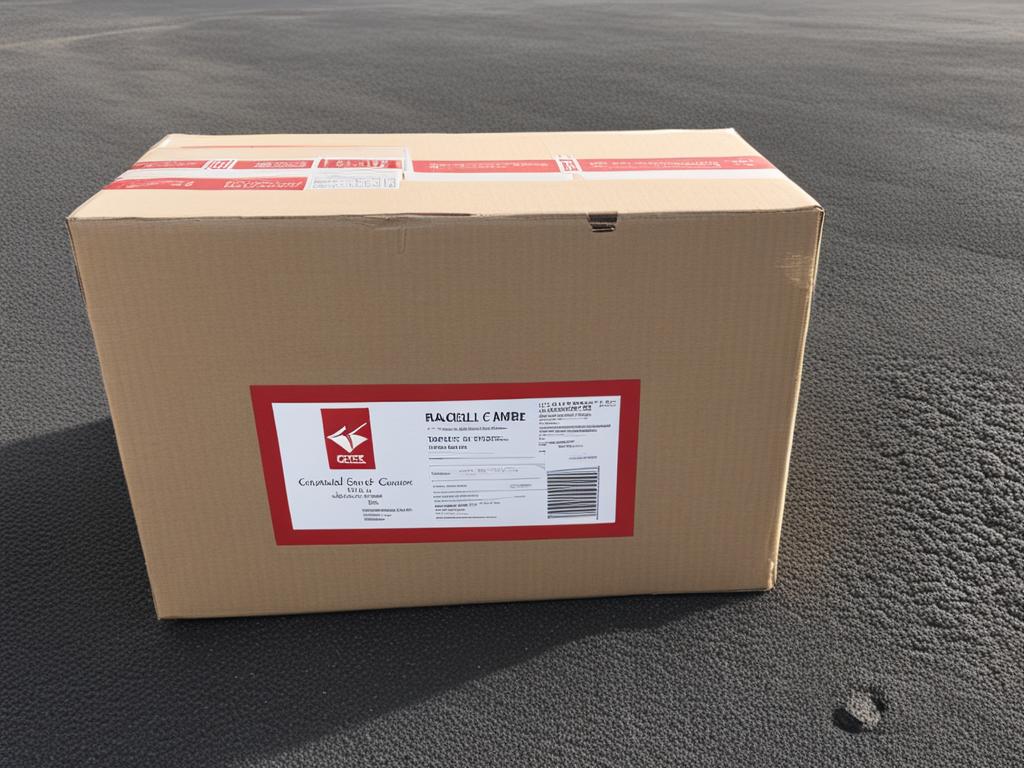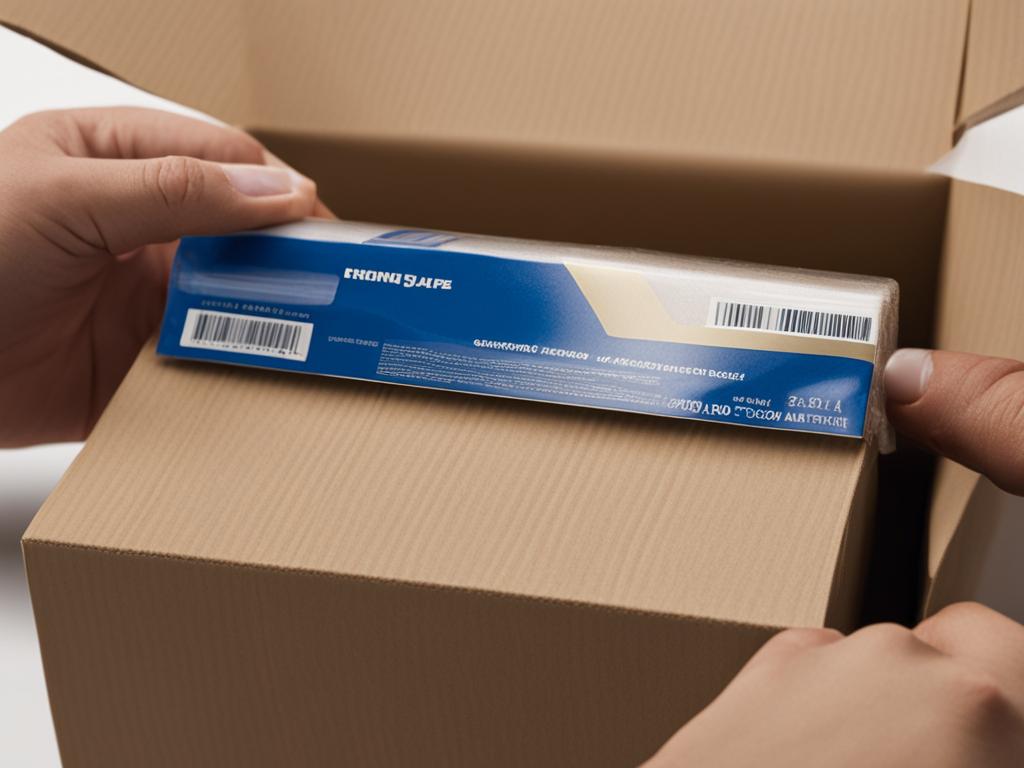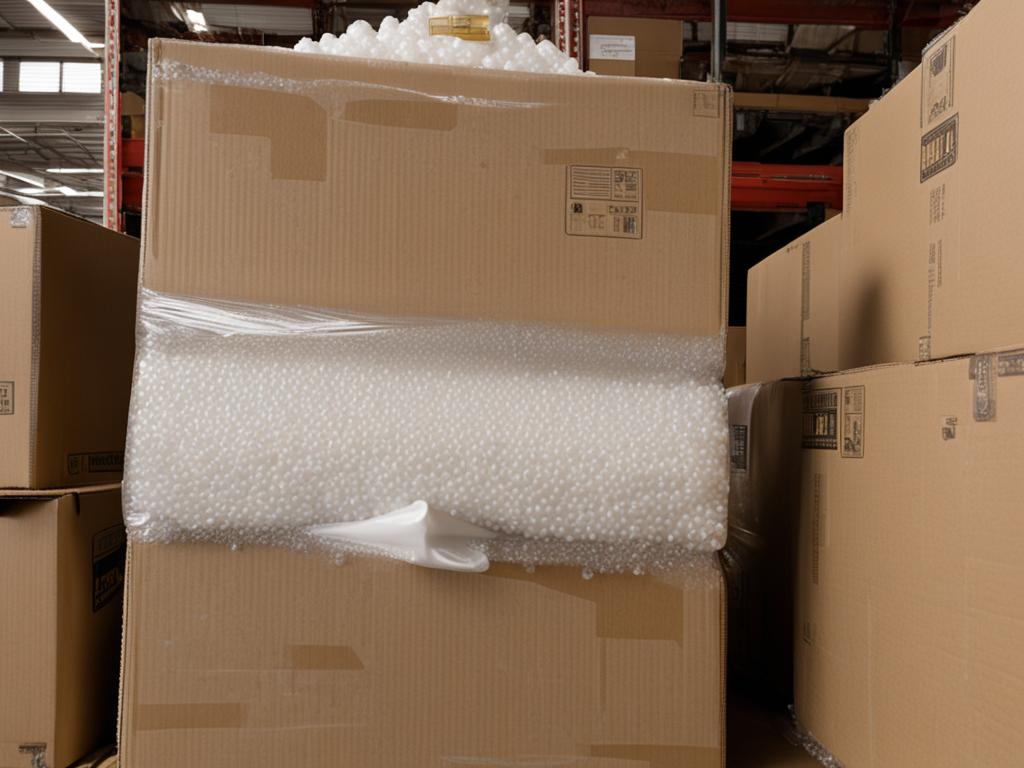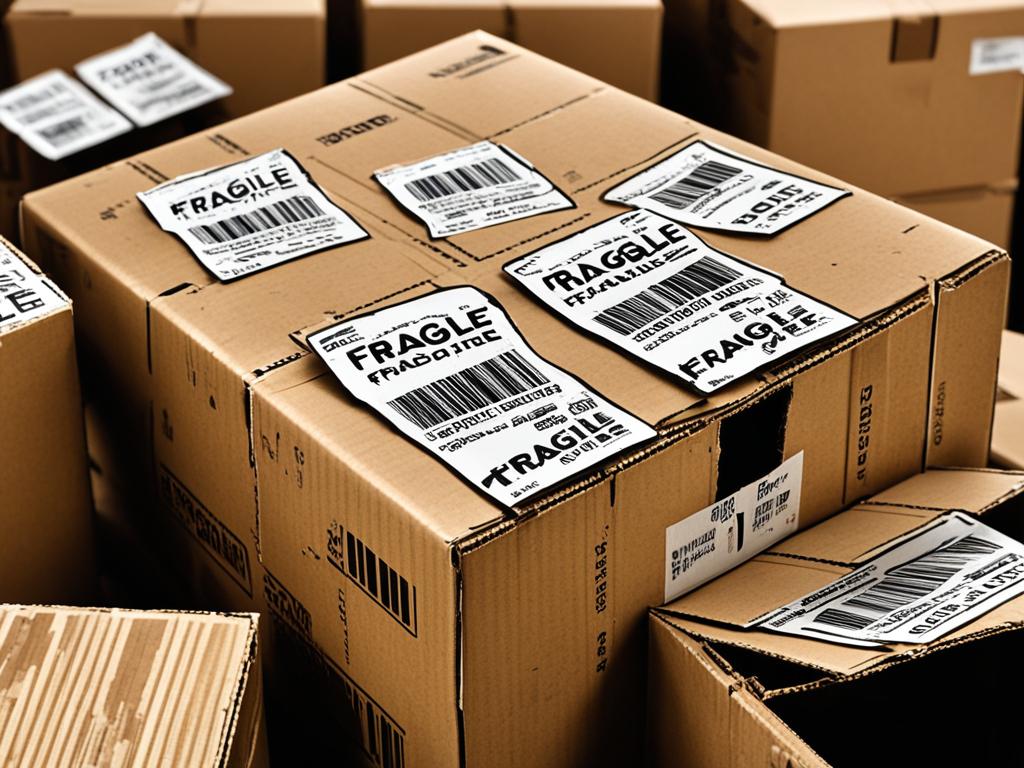Pack & Ship Tips: Fragile Handle With Care Guidance
Shipping fragile items can be a delicate task that requires special attention and care. Whether you’re sending delicate glassware, valuable antiques, or other fragile items, it’s vital to ensure they are properly packaged and handled throughout the shipping process. By taking the necessary precautions, you can help protect your fragile items and ensure they arrive safely at their destination.
Key Takeaways:
- Proper packaging is crucial for protecting fragile items during shipping.
- Choose the right packaging materials, such as rigid boxes and bubble wrap.
- Securely wrap fragile items without applying excessive tension.
- Label the package as fragile and consider additional layers of packaging for long-distance shipping.
- Insure valuable or irreplaceable fragile items for added protection.
What to Consider When Packaging Fragile Items
Fragile items, such as musical instruments and antiques, require special care when it comes to packaging. Proper packaging techniques can help protect delicate items and ensure they arrive safely at their destination. When packaging fragile items, consider the following:
- Choose a rigid box or outer shell: It’s important to use a sturdy box or outer shell to provide structural support and prevent crushing or damage to the fragile item. Select a box that is appropriate in size and shape for the item being packaged.
- Padding is crucial: Place enough padding material, such as bubble wrap or packing peanuts, between the fragile item and the box. This will create a protective barrier and cushion against any potential impact or movement during transit.
- Use strong tape and a shipping label: Secure the box with high-quality packing tape to ensure it stays closed. Additionally, attach a clear shipping label with the recipient’s address and contact information for easy identification and delivery.
- Consider adding an extra address label inside: To be prepared for any unforeseen circumstances, include an extra address label on the inside of the package. This will ensure that the item can still be delivered correctly even if the external label becomes detached or damaged.
By following these guidelines, you can package fragile items effectively and minimize the risk of damage during shipping.
| Considerations when Packaging Fragile Items | Guidelines |
|---|---|
| Box Type | Choose a rigid box or outer shell to provide structural support and protection. |
| Padding | Use sufficient padding materials like bubble wrap or packing peanuts to cushion fragile items. |
| Tape and Labeling | Secure the box with strong tape and attach a shipping label for easy identification and delivery. |
| Extra Address Label | Add an extra address label inside the package to ensure correct delivery in case the external label is damaged. |
https://www.youtube.com/watch?v=rPcobGuSVsc
Top Tips for Safe Packaging and Shipping
When it comes to packaging fragile items for shipping, following proper guidelines is crucial to ensure their safe arrival at their destination. By taking a few important steps, you can minimize the risk of damage during transit and provide added protection to your delicate items.
Choose the Right Box Size
Start by selecting a box that is the appropriate size for your fragile item. It should be large enough to accommodate sufficient padding, yet not too big that the item moves around during shipping. A snug fit will help secure the item and protect it from potential damage.
Wrap and Pad with Care
To safeguard your fragile item, wrap it carefully with bubble wrap or other cushioning materials. This additional layer of protection will help absorb any shocks during transit. Fill any empty spaces inside the box with packing materials, such as packing peanuts or crumpled paper, to prevent movement and ensure the item remains securely in place.
Label the Box as Fragile
One of the most important steps in shipping fragile items is proper labeling. Clearly mark the box as fragile to alert handlers to exercise extra caution when handling it. Using fragile stickers or fragile labels can also help draw attention to the delicate nature of the package and encourage careful handling.
Add Extra Layers of Packaging for Long Journeys
If your fragile item is embarking on a longer journey, consider adding extra layers of packaging for added protection. This could involve using a double box technique, where the item is placed in a smaller box and then packed in a larger one. Additionally, consider reinforcing the package with additional tape to secure all openings and prevent any accidental damage.
Secure Packing Materials are Key
Using high-quality, secure packing materials is essential to prevent any shifting or movement during transit. Ensure that you use strong packing tape to seal all edges and openings of the box. This will provide added reinforcement and reduce the risk of the package coming apart during shipping. Zip-up bags can also be used to contain smaller fragile items within the package.
Fragile Shipping Guidelines
| Guidelines | Description |
|---|---|
| Choose the right box size | Ensure a snug fit to prevent movement |
| Wrap and pad with care | Use bubble wrap and packing materials to absorb shocks |
| Label the box as fragile | Clearly mark the package to ensure careful handling |
| Add extra layers for long journeys | Use double boxing and additional tape for reinforcement |
| Use secure packing materials | Strong tape and zip-up bags keep everything in place |
By following these fragile shipping guidelines and taking the necessary precautions, you can significantly reduce the risk of damage to your fragile items and ensure their safe delivery to their intended recipients.

The Importance of Choosing the Right Packaging Materials
When it comes to shipping fragile items, selecting the correct packaging materials is crucial. The right materials can provide the necessary protection to ensure that your delicate items arrive at their destination intact. Two essential packaging materials for fragile items are bubble wrap and packing peanuts.
Using Bubble Wrap for Added Protection
Bubble wrap is an invaluable packaging material for fragile items. Its cushioning properties help absorb shock and prevent damage during transportation. Before placing your delicate item in the box, wrap it carefully in several layers of bubble wrap. This will provide an extra layer of protection against bumps, jolts, and vibrations that may occur during transit. The air-filled bubbles act as a barrier, protecting your fragile item from impact and ensuring its safe arrival.
Packing Peanuts for Gap Filling and Cushioning
Another essential packaging material for fragile items is packing peanuts. These lightweight and versatile foam pieces are ideal for filling the gaps inside the shipping box and providing additional cushioning. Packing peanuts help stabilize the item, preventing it from shifting or moving during transportation.
To use packing peanuts effectively, fill the bottom of the box with a layer of peanuts. Place the wrapped item on top, ensuring it sits securely. Then, fill the remaining gaps in the box with additional packing peanuts, making sure the item is completely surrounded and protected. This ensures that your fragile item stays in place, minimizing the risk of damage.
| Packaging Material | Advantages |
|---|---|
| Bubble Wrap | – Provides cushioning against impact – Absorbs shocks and vibrations during transit – Easy to wrap around fragile items for added protection |
| Packing Peanuts | – Help fill gaps in the shipping box – Provide cushioning and stabilization for delicate items – Lightweight and versatile for various item shapes and sizes |
Investing in high-quality packaging materials like bubble wrap and packing peanuts is essential for safeguarding fragile items during shipping. These materials offer reliable protection, reducing the risk of damage due to impact or movement during transit.
Protecting Fragile Items from the Elements
Aside from the risk of physical impact, fragile items are also vulnerable to weather conditions during shipping. Rain, snow, and moisture can cause damage to both the packaging and the item itself. To safeguard against these elements and ensure the safe arrival of your fragile items, it’s important to take additional protective measures.
Plastic Bag or Shrink-wrap: Consider using a plastic bag or shrink-wrap to create an extra layer of protection. This will help keep the item dry and shield it from potential weather-related damage.
| Protection Method | Description |
|---|---|
| Plastic Bag | A plastic bag creates a barrier against moisture, protecting the item from potential water damage during transit. |
| Shrink-wrap | Using shrink-wrap creates a tight, weather-resistant seal around the packaging, keeping the item safe from rain, snow, or other external elements. |
By utilizing a plastic bag or shrink-wrap, you can provide an additional layer of protection for your fragile items, ensuring they remain intact and undamaged during the shipping process.

Ensuring Secure Packaging for Fragile Items
When it comes to shipping fragile items, secure packaging is crucial to prevent any movement or shifting during transit. By using strong packing tape, zip-up bags, and the appropriate packing materials, you can ensure that everything stays in place and arrives safely at its destination.
Choosing Secure Packing Materials
Using the right packing materials is essential for secure packaging. Opt for sturdy cardboard boxes or containers that can withstand the rigors of shipping. Additionally, consider using specialized packaging materials specifically designed for fragile items, such as foam inserts or bubble wrap, to provide extra cushioning and protection.
Using Strong Packing Tape
One of the most important elements of secure packaging is using high-quality packing tape. Ensure that you choose a tape with excellent adhesive strength and durability to keep the package sealed and secure. Be sure to apply enough tape to cover all potential openings in the box and secure any loose ends.
Utilizing Zip-Up Bags for Extra Protection
Incorporating zip-up bags into your packaging strategy can provide an additional layer of protection for fragile items. These bags are particularly useful for smaller items or components that require individual packaging. Place the items in the bags, close them securely, and then pack them inside the main shipping box for added security.
By utilizing secure packing materials, strong packing tape, and zip-up bags, you can minimize the risk of damage to fragile items during transit. The extra precautions taken will provide peace of mind and ensure that your items arrive safely at their destination.
| Packing Materials | Packing Tape | Zip-Up Bags |
|---|---|---|
| Sturdy cardboard boxes or containers | High-quality packing tape with excellent adhesive strength | Additional layer of protection for smaller items |
| Specialized packaging materials (foam inserts, bubble wrap) | Ensure enough tape to cover all potential openings | Securely close bags to protect individual items |
Proper Wrapping Techniques for Fragile Items
When it comes to packaging fragile items, the way you wrap them plays a crucial role in ensuring their safe transit. It’s essential to strike the right balance between secure wrapping and avoiding excessive tension. Wrapping delicate items too tightly can increase the risk of damage, especially for items like glassware or antiques. Instead, focus on wrapping the item securely but loosely, providing enough padding and protection without putting too much pressure on the fragile parts.
Start by selecting appropriate wrapping materials such as bubble wrap or packing paper. These materials offer cushioning and protection against impacts during transportation. Place the fragile item in the center of the wrapping material and fold it gently to create a secure layer of padding around it.
Pro Tip: Use additional layers of bubble wrap or padding for extra protection for extremely delicate items.
Once the item is surrounded by the wrapping material, make sure to secure it properly. Use tape to seal the wrapping, ensuring that it stays in place throughout the shipping process. Be cautious not to tape too tightly, as this can exert pressure on the fragile item.
If you’re shipping multiple fragile items together, it’s crucial to wrap each item individually to prevent them from coming into contact with one another. This prevents potential damage caused by friction or collisions between the items.
In wrapping fragile items, always remember to prioritize their safety over expedience. Take the time to ensure each item is securely wrapped and protected.
By following proper wrapping techniques and maintaining a balance between secure wrapping and tension on items, you can significantly reduce the risk of damage during transit. Remember, taking extra care in wrapping fragile items is a small investment that can make a significant difference in ensuring they reach their destination intact.

The Importance of Sufficient Packing Tape
Adequate packing tape is essential for ensuring the security of your package. It plays a crucial role in preventing any accidental openings during transit, protecting the contents inside. When it comes to fragile items, using the right packing tape becomes even more important to minimize the risk of damage.
The H-taping Technique for Extra Reinforcement
One effective technique to enhance the durability of your package is the H-taping technique. This method involves applying tape along the corners and middle of the box, creating an H-shaped pattern. By doing so, you provide extra reinforcement to the critical areas of the package.
Not only does the H-taping technique strengthen the overall structure of the box, but it also covers all potential seams, reducing the likelihood of the package coming apart during transit. This technique is particularly beneficial for fragile items, as it adds an extra layer of protection.
The Importance of High-Quality Packing Tape
Using high-quality packing tape is crucial to ensuring the integrity of your package throughout its journey. Inferior tape may not have sufficient adhesive strength, leading to tape failure and potential damage to the contents inside.
Investing in high-quality packing tape provides peace of mind, knowing that your package is securely sealed. Look for tape specifically designed for shipping purposes, with strong adhesive properties and tear resistance. This type of tape is engineered to withstand the challenges of transportation and keep your fragile items well-protected.
Remember, when it comes to the security of your package, never compromise on the quality of the packing tape. It is a critical component in safeguarding your fragile items during transit.
| Packing Tape Considerations | Benefits |
|---|---|
| Strong adhesive | Ensures a secure seal |
| Tear resistance | Provides durability and prevents tape failure |
| Weather-resistant | Protects the package from moisture and other environmental factors |
| Easy to use | Convenient and user-friendly |
Choosing the right packing tape and applying it correctly using the H-taping technique will help ensure that your fragile items arrive at their destination intact. Don’t underestimate the importance of this often-overlooked component of the packaging process.

Extra Packaging for Long-Distance Shipping
When it comes to long-distance shipping, extra precautions are necessary to protect fragile items from potential damage. With more handling and a higher risk of accidents during transit, it’s essential to ensure that your fragile items are securely packaged.
One effective method is to add extra layers of packaging and reinforcement. This can be achieved by using additional packing materials such as bubble wrap or packing peanuts to provide ample cushioning for your fragile items. Placing the item in a smaller box inside a larger one, commonly referred to as double boxing, can also provide an additional layer of protection.
Another important consideration is to add more tape to secure the package. The use of high-quality packing tape and applying the H-taping technique – where tape is applied along the corners and middle of the box – can help reinforce the package, reducing the risk of accidental openings during transportation.
By following these extra packaging measures, you can significantly minimize the chances of damage to your fragile items during long-distance shipping.

The Importance of Clearly Labeling Fragile Packages
When it comes to shipping fragile items, proper labeling plays a crucial role in ensuring their safe handling and transit. Fragile labels are not just decorative; they serve as important visual reminders for package handlers and couriers to exercise extra caution and delicate handling during the shipping process. Additionally, including specific instructions such as “this side up” can help prevent mishaps and ensure that the package is always oriented correctly.
Proper labeling with fragile stickers or labels serves as an effective communication tool, conveying the delicate nature of the contents inside the package. This way, package handlers are aware of the special requirements for delicate items and can take appropriate measures to avoid rough treatment or mishandling that could lead to damage.
Benefits of Proper Labeling for Fragile Packages:
- Enhanced Package Handling: Fragile labels provide a clear visual cue to package handlers, indicating the need for gentle and careful handling. This reduces the risk of accidental drops or improper stacking that can potentially cause irreparable damage to fragile items.
- Protection against Mishaps: Accidents happen, and even the most diligent packers can’t guarantee a completely smooth journey for their packages. However, with properly labeled fragile packages, handlers are more likely to exercise caution, minimizing the likelihood of mishaps.
- Avoids Rough Treatment: By using fragile labels, you can mitigate the chances of your package being subjected to rough treatment during transit. With clearly marked fragile items, handlers are more likely to take extra care, ensuring that your delicate goods arrive in their intended condition.
To ensure the effectiveness of fragile labels, it’s essential to place them prominently on the package, ensuring their visibility to anyone handling the package. Additionally, it’s crucial to choose high-quality labels that won’t easily fade or detach during transit.
| Key Points | Benefits |
|---|---|
| Fragile labels | Alert handlers to delicate contents |
| Provide clear instructions | Ensure proper orientation and handling |
| Prevent rough treatment | Minimize the risk of damage |

Remember, when it comes to shipping fragile items, proper labeling is a small step that can make a significant difference in protecting your valuable and delicate goods. Take the time to label your fragile packages correctly, and you’ll increase the chances of a safe and damage-free journey for your items.
The Benefits of Insuring Fragile Items
Even with careful packaging and handling, accidents can happen during shipping. Insuring fragile items provides an added layer of protection and peace of mind. Particularly for items of high value or irreplaceable items, insurance can help cover the cost of any damage or loss that may occur during transit. It’s worth considering insurance as a precautionary measure to protect fragile items.
When shipping fragile items, the risk of damage is always present. Despite your best efforts to carefully package and handle these delicate items, unforeseen circumstances during transit can still lead to accidents. That’s where insurance for fragile items comes in. By insuring your valuable and delicate items, you can have peace of mind knowing that you are financially protected in the event of any unfortunate incidents.
Insurance for fragile items offers various benefits. Firstly, it provides financial coverage for any damage or loss that may occur during shipping. This means that if your fragile item gets broken, shattered, or lost in transit, you can file a claim with the insurance company and receive compensation for its value. Whether you are shipping fragile artwork, delicate glassware, or sentimental antiques, having insurance ensures that you won’t be left with a financial burden if something goes wrong.
Insuring your fragile items also offers peace of mind. Knowing that your valuable and delicate possessions are protected against unforeseen accidents and circumstances can alleviate the stress and worry that often comes with shipping fragile items. Instead of constantly fretting about the condition of the package, you can focus on other tasks, knowing that you have taken the necessary steps to safeguard your items.
While some shipping carriers may offer limited liability coverage, it may not be sufficient to fully compensate for the value of your fragile items. By obtaining additional insurance for these items, you can ensure that you are adequately covered. This is particularly important for high-value items or items that hold significant sentimental value, as their loss or damage can be devastating.
Before shipping fragile items, it is crucial to carefully read and understand the insurance policy to determine the coverage limits, deductibles, and any specific requirements or exclusions. Additionally, it’s advisable to document the condition of the items before shipping by taking photographs or creating an inventory list. This documentation can help support your insurance claim in case of any damage or loss.
In conclusion, insuring your fragile items is a wise investment that offers both financial protection and peace of mind. By taking this precautionary measure, you can mitigate the risks associated with shipping delicate and valuable items, ensuring that they are covered in the event of any unforeseen accidents or mishaps. Don’t leave the fate of your fragile items to chance – opt for insurance and ship with confidence.
Conclusion
Shipping fragile items requires careful handling and precise packaging techniques to ensure their safe transit. By following the right steps and using appropriate materials, you can minimize the risk of damage and ensure that your delicate items arrive at their destination intact.
When preparing fragile items for shipping, it’s crucial to choose the right packaging materials. Use a sturdy box or outer shell that provides ample protection and cushioning. Wrap the item securely with bubble wrap or other padding materials, and fill any empty spaces in the box to prevent movement during transit.
Labeling the package as fragile is also essential to alert handlers and couriers to handle it with care. Additionally, for long-distance shipping, consider adding extra layers of packaging and reinforcement to provide added peace of mind.
Remember, each step in the packaging and shipping process, from choosing the right materials to labeling your package, plays a vital role in ensuring the safety of your fragile items. By handling them with care and following these guidelines, you can give your delicate items the protection they need during transit.
FAQ
What precautions should I take when packaging fragile items?
When packaging fragile items, it’s important to use a rigid box or outer shell and ensure there is enough padding between the item and the box. Strong tape, a shipping label, and bubble wrap or packing nuts should also be used.
How should I choose the right packaging materials for fragile items?
The choice of packaging materials is crucial in ensuring the safe transport of fragile items. Bubble wrap provides an extra layer of protection and should be used to wrap the item before placing it in the box. Packing peanuts can be useful for filling gaps and providing cushioning for irregularly shaped items.
How can I protect fragile items from the weather during shipping?
To protect against weather conditions, consider using a plastic bag or shrink-wrap to create an additional layer of protection. This will help keep the item dry and prevent any potential damage from exposure to rain, snow, and moisture.
How can I ensure secure packaging for fragile items?
Secure packaging is essential to prevent any movement or shifting during transit. Using strong packing tape, zip-up bags, and the appropriate packing materials will ensure that everything stays in place. It’s important to use enough tape to cover all potential openings in the box and secure any loose ends.
What are some proper wrapping techniques for fragile items?
When wrapping fragile items, it’s important to find the right balance between securing the item and avoiding excessive tension. Wrapping too tightly can increase the chances of damage, especially for delicate items like glassware or antiques. Instead, wrap the item securely but loosely, ensuring that there is enough padding and protection without putting too much pressure on the fragile parts.
How important is sufficient packing tape when packaging fragile items?
Adequate packing tape is essential to keep the package secure and prevent any accidental openings during transit. The H-taping technique, where tape is applied along the corners and middle of the box, provides extra reinforcement and covers all potential seams.
What additional packaging should I consider for long-distance shipping of fragile items?
For long-distance shipping, it’s advisable to add extra layers of packaging and reinforcement. This can involve using additional packing materials, double boxing, or adding more tape to secure the package.
How important is it to clearly label fragile packages?
Clearly labeling fragile packages is essential to alert package handlers and couriers to the delicate nature of the contents. Fragile stickers or labels can help prevent mishandling or rough treatment of the package during transit.
Should I consider insuring my fragile items?
Insuring fragile items provides an added layer of protection and peace of mind. Particularly for items of high value or irreplaceable items, insurance can help cover the cost of any damage or loss that may occur during transit.
How can I ensure the safe shipping of fragile items?
To ensure the safe shipping of fragile items, it’s important to choose the right packaging materials, secure the item inside the box, label the package as fragile, and consider additional layers of protection for long-distance shipping. Following these guidelines will minimize the risk of damage during transit.




